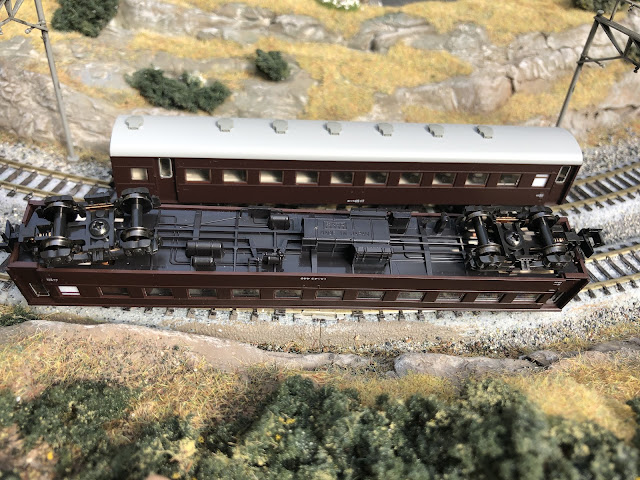There's a review of the freight car starter pack elsewhere on this blog. It's the passenger car pack that's being looked at now, one of two in fact. One contains four coaches in the old (post-war) brown livery of JNR, while the other contains four coaches in the JNR blue livery introduced in 1964 and consequently more typical of trains after the steam era. While the contents of the two packs appear similar (apart from the colours, of course) they do not include exactly the same four types of coach.
Background
Nowadays, multiple unit trains, particularly electric multiple units, carry most of the passengers on Japanese railways. But in the past, coaches (or passenger cars) of various kinds were common. The ones included in this Kato pack represent postwar (JNR) designs that would be hauled by locomotives such as the D51 for long distances or C11 and C12 tank engines on branch lines. They were built between 1951 and 1955, though modernised and modified in later years, for example by having air conditioning installed and the wooden-framed windows replaced with ones with aluminium frames.
Most of these old coaches were phased out of use during the early 1980s, but a few remain in service even today for special trains such as excursions behind steam locomotives. This makes this sort of pack useful even for modellers setting their layouts in the present day. There was also a long period of time during the 1960s and 70s where the original brown coaches and the refurbished blue coaches might be marshalled into the same train. So, again, while this pack is ideal for the steam-era modeller, it will also have use on layouts featuring diesel and electric locomotives.
The basic design of these coaches will be familiar to modellers from all around the world: steel frames with wooden bodies, two-axle bogies, corridor connections, and air vents (rather than air conditioning) on the roof to provide ventilation in summer. Although built to mainline standards, and frequently used on named express trains, these coaches were not designed to run at speeds above 95 km/h.
Kato Freight Car Park (10-033)
- Suyuni 60 baggage/mail car with working taillights
- Oha 46 third class open car
- Suha 43 third class open car
- Ohafu 45 third class (brake) with working taillights
- Tool for moving the light switches on and off
The four coaches are pretty similar in specification, with Rapido couplings, all-wheel axle-point electrical pick-up, chemically-blackened disk wheels, and removable roofs that allow for quick installation of the Kato lighting kit.
At first glance they all look pretty similar, but the shade of grey used for the roof varies between the light grey of the Ohafu 45 and the dark grey used on the other three cars. The livery is simple but nicely applied, with a satin finish and very neat lettering. The inside details are all moulded in the the one colour.
There are essentially no fitted details beyond the corridor connection frames. Handrails, footsteps, lamps, etc., are all moulded onto the body. While this works well enough, it doesn't quite match the standards seen on the state of the art passenger cars (like the Farish-Bachmann 'blue riband' series in the UK).
Two of the cars come with red taillights at one end. These can be switched on or off using a sliding switch underneath. Turning the coaches over also reveals the underframe detailing that includes brake piping, water tanks, etc. You can also see how the Rapido couplings are fitted onto the bogies with the usual copper spring behind them to keep them centred. These can be upgraded to knuckle couplers (Kato #11-702) or magnetic couplers (Kato #11-711) if preferred, but these alternate couplings are not included in the set.
Conclusion
As with the freight car pack, there's a lot of value in this set. The RRP in Japan is 8,250 Yen (about £43 at the time of writing) which compares very favourably with the RRP of coaching stock in the UK. Basically, for what you're getting here, you'd be lucky to get one, maybe two British outline coaches. But with that said, the specification here is a bit mixed. Interior lighting is always nice, but the lack of separately fitted detailing results in a rather 'flat' appearance when examined closely.
So, while you are getting a good set of coaches, serious modellers might want to make a few upgrades to bring things up to modern standards. One other obvious upgrade worth doing is the replacement of the disc wheels with more authentic spoked wheels. Presumably, these were not included as standard to keep costs down. Similarly, if you install the lighting kit, the lack of passengers will become more obvious, so you might want to do is add some passenger figures. Needless to say, Kato do their own, but since figures inside models aren't easily seen, you could just as easily use the economical (if garishly painted) figures sold in eBay and the like.
Overall though, this is a good way to get some passenger trains up and running on your layout, whether you're modelling the steam era or early diesels and electrics.







No comments:
Post a Comment